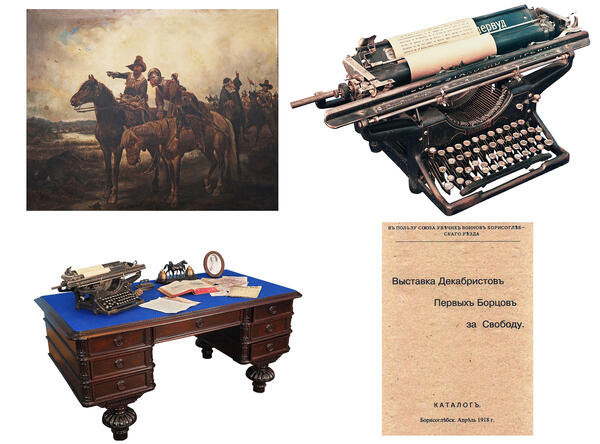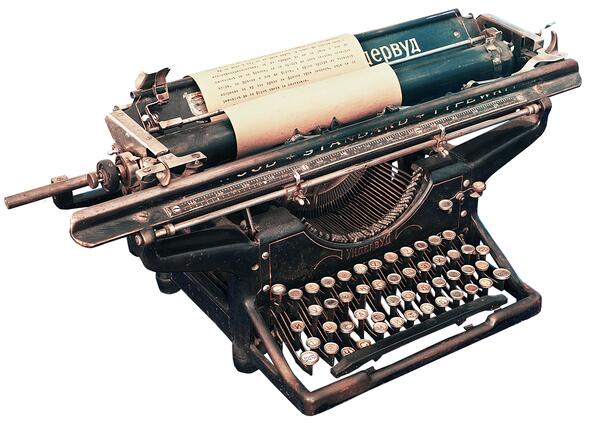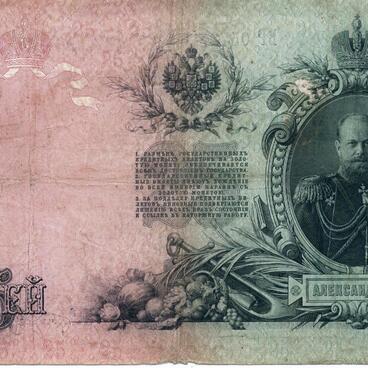The wooden desk belonged to prince Serge Volkonsky (1860-1937), one of the foremost figures in the artistic and cultural life at the turn of the 20th century. An intellectual and a sensible person, for the whole life he was fascinated with theatre art, held a position of a director of the Imperial Theatres. His great influence expressed itself in the improvement of quality and technique of acting. In the memory of his famous grandfather Sergei Grigoryevich Volkonsky he organized an exhibition dedicated to the Decembrists in the building of People’s House in 1918. It was named Decembrists as the First Freedom Fighters.
This showpiece was situated in Serge Volkonsky’s house, in his study. The desk was made by a local craftsman from Borisoglebsk, the tabletop was covered with thick cloth in accordance with the fashion of the time. The Underwood typewriter used by the prince to write the soldiers’ letters home, when there was a hospital for the wounded ones during the time of the World War I, was situated on the desk. Serge Volkonsky used to write many letters, articles, and other printed manuscripts at this desk.
The story of the desk’s appearance was described by the prince in his book My Memoirs. The prince contacted a head of the uyezd Ivan Olenin with this question. This is how he described him in his notes: ‘Our head of the uyezd Ivan Olenin was worth special mention. He was voted for many times, for three years each time. But what for? Only for a reason there was no one else to vote for. It was a remarkable phenomenon. I’ve never seen any living creature looking so much as a literary character as Ivan Pavlovich looked like Sobakevich.
Cynicism and lightness of his lies surpassed all the possibilities. He used to tell about himself, ‘what kind of a leader am I? I’m a kulak, not a leader.’ I remember when I needed a desk. When he found out, he told me he had one he wanted to sell.’ As a result, Ivan Olenin sold a desk to the prince for 70 roubles after haggling over the price. Serge Volkonsky showed his acquisition to the local pharmacist Robert Weiss, who recommended a cabinet-maker for repairing the desk. The cabinet-maker recognized the table he made himself and said that he’d sold it for 50 roubles. In the end of his story the prince compared his acquisition to the Sobakevich’s road cart.
This showpiece was situated in Serge Volkonsky’s house, in his study. The desk was made by a local craftsman from Borisoglebsk, the tabletop was covered with thick cloth in accordance with the fashion of the time. The Underwood typewriter used by the prince to write the soldiers’ letters home, when there was a hospital for the wounded ones during the time of the World War I, was situated on the desk. Serge Volkonsky used to write many letters, articles, and other printed manuscripts at this desk.
The story of the desk’s appearance was described by the prince in his book My Memoirs. The prince contacted a head of the uyezd Ivan Olenin with this question. This is how he described him in his notes: ‘Our head of the uyezd Ivan Olenin was worth special mention. He was voted for many times, for three years each time. But what for? Only for a reason there was no one else to vote for. It was a remarkable phenomenon. I’ve never seen any living creature looking so much as a literary character as Ivan Pavlovich looked like Sobakevich.
Cynicism and lightness of his lies surpassed all the possibilities. He used to tell about himself, ‘what kind of a leader am I? I’m a kulak, not a leader.’ I remember when I needed a desk. When he found out, he told me he had one he wanted to sell.’ As a result, Ivan Olenin sold a desk to the prince for 70 roubles after haggling over the price. Serge Volkonsky showed his acquisition to the local pharmacist Robert Weiss, who recommended a cabinet-maker for repairing the desk. The cabinet-maker recognized the table he made himself and said that he’d sold it for 50 roubles. In the end of his story the prince compared his acquisition to the Sobakevich’s road cart.






